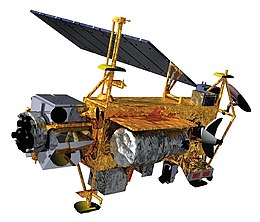Upper Atmosphere Research Satellite
 |
|
| Mission type | Earth observation |
|---|---|
| Operator | NASA |
| COSPAR ID | 1991-063B |
| SATCAT № | 21701 |
| Website | http://umpgal.gsfc.nasa.gov/ |
| Mission duration | 14 years, 3 months |
| Spacecraft properties | |
| Bus | Multimission Modular Spacecraft |
| Manufacturer | Martin Marietta |
| Launch mass | 6,540 kilograms (14,420 lb) |
| Dry mass | 5,900 kilograms (13,000 lb) |
| Power | 1600.0 watts |
| Start of mission | |
| Launch date | 12 September 1991, 23:11:04 UTC |
| Rocket | Space Shuttle Discovery STS-48 |
| Launch site | Kennedy LC-39A |
| Contractor | NASA |
| End of mission | |
| Disposal | Decommissioned |
| Deactivated | 15 December 2005 |
| Decay date | 24 September 2011 |
| Orbital parameters | |
| Reference system | Geocentric |
| Regime | Low Earth |
| Semi-major axis | 6,953.0 kilometers (4,320.4 mi) |
| Eccentricity | 0.0003645 |
| Perigee | 574.0 kilometers (356.7 mi) |
| Apogee | 575.0 kilometers (357.3 mi) |
| Inclination | 56.97999954223633° |
| Period | 95.9 minutes |
| Instruments | |
|
CLAES ISAMS MLS HALOE HRDI WINDII SUSIM SOLSTICE PEM ACRIM II |
|
The Upper Atmosphere Research Satellite (UARS) was a NASA-operated orbital observatory whose mission was to study the Earth’s atmosphere, particularly the protective ozone layer. The 5,900-kilogram (13,000 lb) satellite was deployed from Space Shuttle Discovery during the STS-48 mission on 15 September 1991. It entered Earth orbit at an operational altitude of 600 kilometers (370 mi), with an orbital inclination of 57 degrees.
The original mission duration was to be only three years, but was extended several times. When the mission finally ended in June 2005 due to funding cuts, 14 years after the satellite's launch, six of its ten instruments were still operational. A final orbit-lowering burn was performed in early December 2005 to prepare the satellite for deorbit. On 26 October 2010, the International Space Station performed a debris-avoidance maneuver in response to a conjunction with UARS.
The decommissioned satellite re-entered Earth's atmosphere on 24 September 2011. Considerable media attention surrounded the event, largely due to NASA's predictions that substantial parts of the satellite might reach the ground, potentially endangering inhabited areas. However, the satellite ultimately impacted in a remote area of the Pacific Ocean.
CLAES was a spectrometer that determined the concentrations and distributions of nitrogen and chlorine compounds, ozone, water vapor and methane. It did this by inferring the amount of gases in the atmosphere by measuring the unique infrared signature of each gas.
In order to differentiate the relatively weak signature of trace gases from the background radiation in the atmosphere, CLAES had to have high resolution and sensitivity. To achieve this, the instrument combined a telescope with an infrared spectrometer. The whole instrument was cryogenically cooled to keep heat from the instrument from interfering with the readings. The cryogenics system consisted of an inner tank of solid neon at −257 °C (−430 °F) and an outer tank of solid carbon dioxide at −150 °C (−238 °F). As the neon and carbon dioxide evaporated, they kept the instrument cool for a planned 19 months. The final cryogens evaporated from the instrument on May 5, 1993 and the instrument warmed up, ending its useful life.
...
Wikipedia
